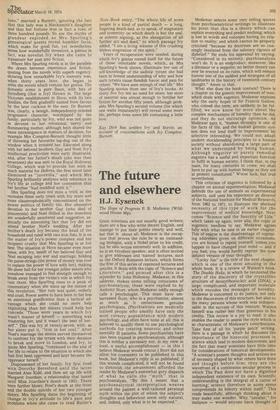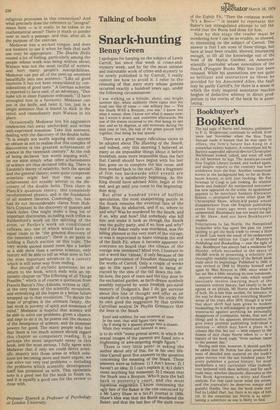The future and elsewhere
H.J. Eysenck
The Hope of Progress P. B. Medawar (Wildwood House 90p).
Great scientists are not usually good writers; there are a few who write decent English, and manage to put their points clearly and well, but that is about all. Medawar is the exception that proves the rule; he is an outstanding biologist, with a Nobel prize to his credit, but he also writes extremely well. In addition, he is an excellent speaker, and is often invited to give addresses and 'named' lectures, such as the Oxford Romanes lecture, which forms the first of this series of reprinted lectures and articles. It deals with the topic of "Science and Literature," and printed after this is a rejoinder by John Holloway. Medawar, in this address, makes some telling criticisms of psychoanalysis; these were replied to by Anthony Storr, whom Medawar oddly enough calls a psychologist. This must have embarrassed Storr, who is a psychiatrist, almost as much as it embarrasses genuine psychologists. (Psychiatrists are medically trained people who usually have only the most cursory acquaintance with modern psychology, and often have none at all; this is believed to qualify them to use psychological methods for treating neurotic and other mentally ill patients. Some psychiatrists have also been trained in psychoanalysis, although this is neither a necessary nor, in my view at least, a useful accomplishment — in this I believe Medawar would concur.) Storr did not allow his comments to be published in this book, but Medawar's reply is so published; if this sounds complicated, it will not be found to diminish the amusement afforded the reader by Medawar's somewhat gory dispatch of what he calls the "myth" that is psychoanalysis. "By this I meant that a psychoanalytical interpretation weaves around the patient a well-tailored personal myth within the plot of which the subject's thoughts and behaviour seem only natural, and, indeed, only what is to be expected."
Medawar selects some very telling quotes from psychoanalytical writings to illustrate his point that this is a theory which can explain everything and predict nothing; which is lost in words and concepts having no relation to reality; and which cannot be properly criticised "because its doctrines are so cunningly insulated from the salutary rigours of disbelief." He ends his appraisal by saying: "Considered in its entirety, psychoanalysis won't do. It is an endproduct, moreover, like a dinosaur or a zeppelin; no better theory can ever be erected on its ruins, which will remain forever one of the saddest and strangest of all landmarks in the history of twentieth-century thought." Amen to that.
What else does the book contain? There is a chapter on the genetic improvement of man, which deals with eugenics. Medawar explains why the early hopes of Sir Francis Galton, who coined the term, are unlikely to be fulfilled; we now know far more about the complex mechanisms of heredity than he did, and they do not encourage optimism. As Medawar puts it, "human diversity is one of the facts of life, and the human genetic system does not lend itself to improvement by selective inbreeding. We could not adapt modern stockbreeding principles to a human society without abandoning a large part of what we understand by being human. Although negative or purely remedial eugenics has a useful and important function to fulfil in human society, I think that, in the main, for many centuries to come, we shall have to put up with human beings as they are at present constituted." Worse luck, but true nevertheless.
This criticism of eugenics is followed by a chapter on animal experimentation; Medawai defends the use of animals as experimental subjects, and uses his experience as director of the National Institute for Medical Research; from 1962 to 1971, to illustrate the absolute necessity of this type of work for the improvement of medical knowledge. Next comes "Science and the Sanctity of Life," which takes up again, inter alia, the topic of eugenics; needless to say, Medawar agrees fully with what he said in an earlier chapter. This of course is the disadvantage of reprinting addresses given on different occasions; you are bound to repeat yourself, unless you happen to have changed your mind — and if you had, you would hardly reprint the now defunct version of your thoughts.
"Lucky Jim" is the title of the next chapter, which is one of the most amusing in the whole book. It is a review of Watson's book, The Double Helix, in which he recounted the story of the discovery of the crystalline structure of deoxyribonucleic acid (DNA), a large, complicated, and important molecule which encodes the messages of heredity. Medawar is concerned to do justice, not only to the discoverers of this structure, but also to the many persons whose work was indispensable in the success of this venture; Watson himself was rather less than generous in his credits. This review is a joy to read: it also enables the reader to assess the style which is so characteristic of Medawar's contributions. Take first of all his 'purple patch' writing. Here is a passage in which he discusses the importance of the historical processes in science which lead to modern discoveries, and the fact that many scientists have little time for considerations of historical developments. "A scientist's present thoughts and actions are of necessity shaped by what others have done and thought before him; they are the wavefront of a continuous secular process in which The Past does not have a dignified independent existence of its own. Scientific understanding is the integral of a curve of learning; science therefore in some sense comprehends its history within itself." This reads beautifully, although thinking about it may make one wonder. Why "secular," for instance — would anyone have thought of religious processes in this connection? And what precisely does the reference to "integral" mean here — is it really to be taken in its mathematical sense? There is much to ponder over in such a passage, and that, after all, is the purpose of the exercise.
Medawar has a wicked tongue, and does not hesitate to use it when he feels that such use may be appropriate. The Double Helix roused a lot of feeling, particularly among the people whose work was being written about; Watson was not the most tactful of writers, and hurt many people's susceptibilities. Medawar can put all of the pent-up emotions beautifully into one sentence: "Like all good memoirs it has not been emasculated by considerations of good taste." A German scientist is reported to have said, of an adversary, "Den habe ich in einer Fussnote erdrosselt." (I have strangled him in a footnote). Medawar can put in the knife, and twist it, too, just in a single sentence that is bound to stick in the mind, and immediately puts Watson in his place.
Occasionally Medawar lets his aggressive tendencies run away unchecked, and writes well-expressed nonsense. Take this sentence, dealing with the discovery of the double helix: "It is simply not worth arguing with anyone so obtuse as not to realise that this complex of discoveries is the greatest achievement of science in the twentieth century." At the risk of being declared "not worth arguing with," let me state simply what other achievements of science are thus declared infra dig. There is Einstein's theory of relativity, both the special and the general theory; some quite competent scientists might feel that this was an achievement not notably inferior to the discovery of the double helix. Then there is Planck's quantum theory; this completely revolutionised physics, and is the foundation of all modern theories. Cosmology, too, has had its not inconsiderable claims from Hubble's Constant to the discovery of quasars and black holes. One might make a long list of important discoveries, including such trifles as Rutherford's work on the splitting of the atom, or Pavlov's work on conditioned reflexes, any one of which would have an equal claim to be "the greatest discovery of the twentieth century"; there is no point in holding a Dutch auction on this topic. The very words quoted sound more like a barker at a side show than a serious scientist; only history will be able to tell us what were in fact the most important advances in a century which is still some way from ending.
But enough of stylistic questions; let us return to the book, which ends with an optimistic chapter on"The Effecting of all Things Possible," which is of course a quotation from Francis Bacon's New Atlantis, written in 1627, at the very dawn of the scientific revolution, and embodying all the hopes in a better future wrapped up in that revolution. "To deride the hope of progress is the ultimate fatuity, the last work in poverty of spirit and meanness of mind." Medawar is hopeful that science will be able to solve our problems, given a chance, and tine to do it in; he points out the recency of the emergence of science, and its immense powers for good. The many people who feel that there is too much science should regard this chapter as compulsory reading. It is perhaps the most important essay in this book, and the most serious. I fully agree with Medawar that if only we could direct scientific enquiry into those areas in which solutions are becoming more and more urgent, we can solve our very real problems — including the problems which scientific development itself has presented us with. This optimistic note is a good one for the book to finish on, and it is equally a good one for the review to close with.
Professor Eysenck is Professor of Psychology at London University.



































 Previous page
Previous page